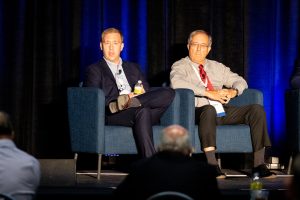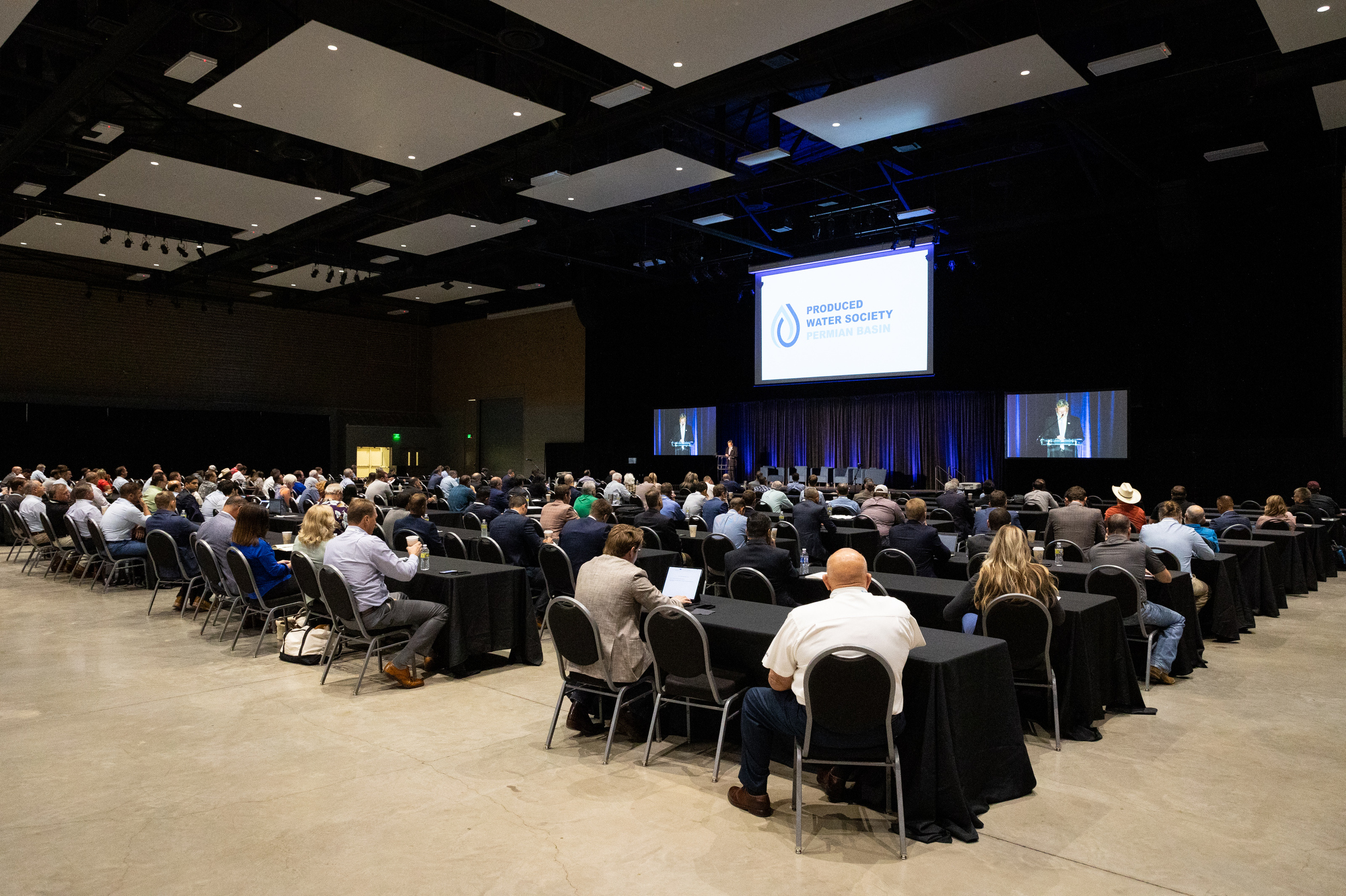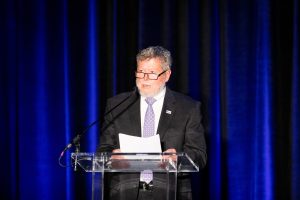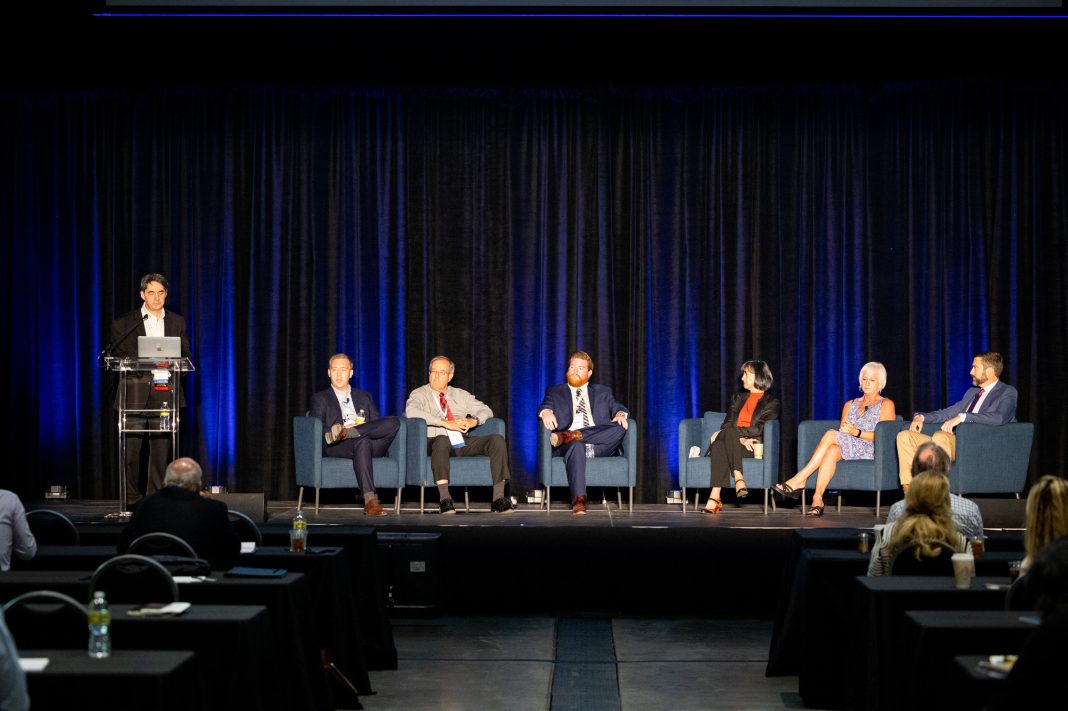With so many smart people working on the oilfield’s produced water dilemma, the answer — or answers — can’t be far away.
That was the conclusion of speakers Tuesday at a Produced Water Society seminar at The Horseshoe Arena & Pavilion in Midland, where Texas Railroad Commissioner Jim Wright began the two-day event with a review of his agency’s work to quell the earthquakes that have rattled the Permian Basin.

“We have seen earthquakes increase as we permitted saltwater disposal wells over places where there were faults,” Wright said afterward. “We’ve gained a lot of knowledge in a short amount of time and the earthquakes have abated where we have taken areas of concern with deep injections and put them back into shallow areas.”
Wright said the economics of making good uses of produced water from fracking for oil and gas deposits instead of pumping it back into the ground are as important as the scientific issues.
Asked if produced water can be used for agriculture, he said it seems increasingly feasible to grow non-edible crops, but applying it to edible crops is not yet within reach.
“The natural vegetation in the Permian Basin is more conducive to salinity than any area of Texas other than the Gulf Coast,” Wright said. “An old rancher once told me that if you put fresh water on mesquite trees, it would kill them.”
Michael Dunkel, an oil, gas and water management engineer for the Tetra Tech Co. of Southlake, told the 300 people attending the Tuesday morning session that research into the problem “has been non-stop” in recent years.
“Infrastructure is critical,” Dunkel said. “Pipelines will be part of the solution.”

John Durand, President of XRI Holdings, moderated a panel discussion among U.S. Department of Energy research engineer Markus Drouven, Mike Hightower of the New Mexico Produced Water Research Consortium, Rusty Smith of the Texas Produced Water Consortium, Laura Capper of the EnergyMakers Advisory Group in Houston, former ConocoPhillips executive Karen Work and Texas Alliance of Energy Producers President Jason Modglin.
Drouven, part of the DOE’s Produced Water Optimization Initiative, said his goal “is to develop software and find ways to better manage, treat, and when possible, find beneficial re-uses” of the salty, chemically contaminated water and to help preserve West Texas’s perennially short fresh water supplies.
“First we need to build a framework,” Drouven said. “How do we build treatment facilities and how big do we make them? We are not rule-makers. Our goal is to help with the solution.”
Explaining that striking a balance among New Mexico’s many interested parties is difficult, Hightower jokingly described himself as “a marriage counselor for all the entities.
“Nobody wants to agree on the technical issues, but we must move forward and do something beneficial,” he said. “I think we can work together and do what’s needed because we’re short of water.”
Chuckling, Smith quipped, “I guess I’m the marriage counselor of Texas!
“We have a report due to the Texas Legislature in two weeks, trying to figure out how we’re going to move forward into the next generation of this challenge that is before us,” Smith said. “The State Water Plan says we will be seven million acre feet short of water in 50 years, so we’re trying to find and develop new water resources wherever we can.”
An acre foot of water is the equivalent of an acre of water a foot deep.
Capper said her group is working with multiple technical groups that are involving landowners while Work reported that seeking an answer “is the most challenging, most technically complex thing I have ever done.”

Modglin said the urgency has been heightened by the most severe drought that West Texas has experienced in 10 years.
Titled “Navigating the Great Reset,” the seminar is also being participated in virtually by 50-100 people, said Produced Water Society President Steve Coffee of Fresno, Calif.
America’s 900,000 oil and gas wells generate 21 billion barrels of produced water each year and industry spokesmen say clean water is used for fracking because it gets the best results.
With 64 speakers from thoughout the nation, the event also had Rob Bryant of B3 Insight from Denver, Nathan Alleman of ALL Consulting from Tulsa, Kyle Murray of Murray GeoConsulting from Norman, Okla., and Capper talking about “Feeling the Seismic Pressure” at 1 p.m. Tuesday.
“The What, Where, How and Why of Environmental, Social and Governance at $100-Per-Barrel Oil” was taken up Tuesday afternoon by Kylie Wright of B3 Insight, Mark Patton of Hydrozonix from Odessa, Brian Bohm of the Apache Corp. and Sharlene Leurig of Texas Water Trade from Austin.
Midland Mayor Patrick Payton will open Wednesday’s program and be followed by Rick McCurdy of Select Energy Services from Houston and others discussing “Produced Water’s Role in the Circular Economy” at 8:45 a.m.
UTPB Chemical Engineering Professor Ubadire Onyemaobi will be among those reviewing “Treatment Focus: Let’s Get Physical” an hour later.
The last topic will be “Treatment Focus: Chemical Concerns” from 3:15-4:15 p.m. Wednesday with Steve Wood of the Catawater Group of Companies of Plano detailing “The Use of Organic Chemistry as a Pre-Process Conditioner for Produced Water Treatment,” Tanhee Galindo of GeoKimika Oil & Gas of Midland discussing “Monitoring the Corrosive Effects of PW and Treatment Chemicals on Frac Iron” and Greg Simpson of PureLine treatment Systems in Bensenville, Ill., explaining “Ferrate vs. Chlorine Dioxide for Sulfide Control.”




